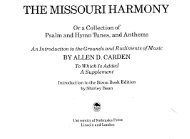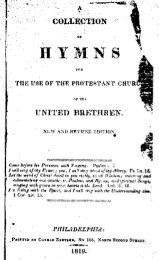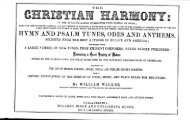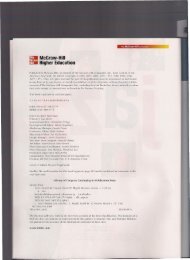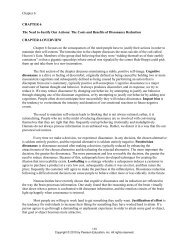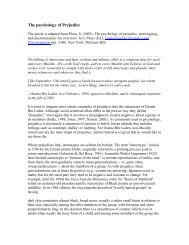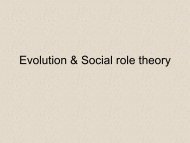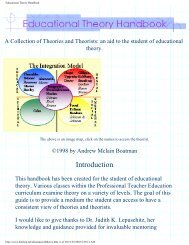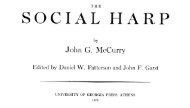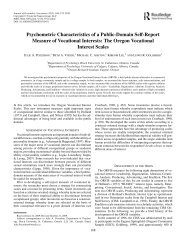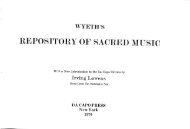Cleavage Structures.pdf
Cleavage Structures.pdf
Cleavage Structures.pdf
You also want an ePaper? Increase the reach of your titles
YUMPU automatically turns print PDFs into web optimized ePapers that Google loves.
nfril?-?:Jormallv integrated into the nation-state, the rurar<br />
/ -#:T*l<br />
The conditions to.<br />
ll: _devetopment ot<br />
{i,s1incL!ve working_"tu* purl.<br />
J#::"f il5itl,*:t'::,:lly",;",'tlyv';;d:#;il11{iT;'uift eiences<br />
48 .LEA'AGE srRucruREs' pARTy sysrEMs, AND vorER ALT.NMENT<br />
il" *;lfffi;:t"t'illt<br />
accentuated long-established tines ot Jivisioi within<br />
velopments.rrrieenougr,"in"iSii-"iji#T;':f"'"$::1"T.'.sff ,",3##,_.:-+r:,Li:*.r_f<br />
::rfs<br />
o:o.:ojprgdugclear_cutpredictionsof thesede_<br />
working-class movemenE gmerg.ed i" tu" ftogstant-dominated countries with<br />
the smoothest histories of o"fioo_Urritdog; g1i1ein, Denmark, and Sweden<br />
(types I and II rn ":::gtEq*ffi"f,o", the C;athotic_dominated coun_<br />
trics witb difficult or -verr- reccnt tiirtoii", o,f nation-buirrring also produced<br />
$:ii'jti:::+"H'rut;r,.ru"x'ffixH^ff t#:1:;I;Hii,I,,1I;<br />
account for variation: io-th9 iot"*.ai"d!99e-!etneen the protestant North_<br />
west and the Latin t"g qrJ* Itr;d *, Vrf and VIII). Both the Aus_<br />
uian and the German *-oti6ig*fu* iiJ".rot deveroped their distinctive<br />
countcr-cultures asainst the- do"minantl",i"ra efites. Th.e auit iuo sociarist<br />
Lag",, heavilv coicentrated * it ;;;-vi"*u, was able to maintain its<br />
unity in &e fice of the a"ii.rr-ll"r;;ilu., and the pan-German nationar_<br />
ish after the dissorutiol ot o" uffiri't-pi.".r, By contrast, the German<br />
working-class movement was deepry oviiea atpl ttre 6"r""ii. igr8. Sharpry<br />
contrasted conceptions of the *i"" ;i th;poltical g;;;;d opposed to<br />
each other and dere to prove t"t"r:io tn" nght against the wave of mass na_<br />
tionalism of the early tLilies.;;- I"' s;;-ii;4a- u" -N!,ri".r.""os ( both<br />
type IV in our scbenie), td i*;d -?iry c;;;;;ffi; produced<br />
a few disturbances- bur the leftwaJsptit-on, t oo, ,rr";;'*rking crass<br />
by parties were of iitu" rilnid.;;;:Hfilrked curtural and rerigious creav_<br />
to r tne -ioci"ri'1 p.,tl.l^ ;#il;i'"ditions or<br />
;ftrJ:ffi'"t _ uvrp<br />
,.'r Of a' ^, .L^-:_-- ttre_inten_r-.rv "i:"5::944' uctl cuuy_lnro natlonal politics.<br />
Iy to help their entry i"tb ouiiJ"ui;iil"..,<br />
rcnCi'*',ffi *!"ff YI1. :ii:' Tgd:r )<br />
a particularrv diffcurt r'i',"]i 6t<br />
""ii.*t"iff;;ffii, i$;lTrl,,l?"""t *'*<br />
ffit#"*1, ""* ili"ilffi; #T? ffi*31y1.:y-llis,case ffi;ffi<br />
tr,1'*"n""J' ffi ;? ffi;ffi#<br />
;1:T:"T.*:1:"q,,11","^"j:l"S-;;"Gfr..#TnffiTil'"'if; .::f :it&T:,S<br />
ilf-ffi gfrHff Belgian-French 1;Iil,Hyi"n"'i"i"l.i;;;,;h'i#:i:il'i::;i"$:f contrasts :f<br />
: 8{<br />
The reconciliation of<br />
social order. divirlarr ,Jl:"":t5l":.^1l.Hng class- to rhe political aod<br />
li?"ir,?"f il._q1*:,*::r1..{:1",-.,T'H""'ff :,fr.l&11ll*i,;<br />
11^ 1t Fremish-Walloon quesriron,<br />
lglon<br />
makes a vivid-coitrast witrr'itre<br />
;#::,TJ:"::*f .^"-^y:rin;;;;;;il"J,lilHrl#.ii:XI" t;i:f<br />
jff<br />
$j:',.Hi "*."":,:3;" ':.r:"""-*.-i:l,i,l""s#,iiii#ieg:#lH'l<br />
j":{,::^::1.:^::f _*J,-:-:,i"*ffi:;#:Hi;:.9:":::[<br />
HS;ffi i:r,:,:::*.:*:i:rl:i;";ij't"Um{"fi Jf':'il,':,:lJl'H:<br />
iii,:#J:L'l#i?,??1,."uu1ff :*-t,-"^i;i,;'.";1iliffi<br />
itfjl3ll:it::::::.{G;;n"ai-;;il:tlihff "",SXlil"i:lr'".,ti;;<br />
fi SJii;,,x",11"i,"J<br />
I'X*IX' ;;;;b;#' ffi i;:il:.'ii:,:1ff1:f "#,,:X:<br />
<strong>Cleavage</strong> <strong>Structures</strong>, Party Systems, and Voter Alignments 49<br />
t/_C@e<br />
"the cockpit of Europe," could not permit itself social aud political<br />
couflict td the breaking point. Perhapi France could not either, but it<br />
was harder for the bigger natiou to realize it.<br />
The cpntrastbetween France* Italy,-andspain-on-th" one b4pd^. and Austria'ana<br />
negium on in" othet suggeiis-a possiule generalization. G-woiking-*<br />
ctes*sorzemeglljg,14ld to be much more divided in the countries where the<br />
"nation-builders"<br />
other during the crucial phases of educational development and mass mobilizatiou<br />
(our "S" cases, types V and VI) than in the countries where the<br />
Church had, at least initially, sided with the nation-builders against some<br />
cornmon enemy outside (our "R" cases, an alliance against Protestant Prussia<br />
and the dependent Hapsburg peoples in the case of Austria; against the Calvinist<br />
Dutch in the case of Belgium). This fits the Irish case as well. The<br />
Catholic Church was no less hostile to the English than the secular nationalists,<br />
and the union of the two forces not only reduced the possibilities of a<br />
polarization of Irish politics on class lines but made the likelihood of a Communist<br />
splinter of any importance very small indeed.<br />
It is tempting to apply a si<br />
the greater the internal division during the struggle for nationhood,<br />
greaterlth-e-"flrgqglg!_lbe*Bugsleg,-Rev,qhtion_aU:be-tliviqions*ryithinlhg_<br />
-wor[fig class"-Wmntalreadt pointed to the profoundffiwithin the<br />
Geinrln Reich was a^late-comFiffiong European<br />
nations, and none of the_'lgrritolal icts within the<br />
=and.telig<br />
,,ladpg was anywhere near set ss parties<br />
- egte{-gd the political arena. ArUeIlg the northern countries the two oldest na-<br />
-tioni,DennrirkandSweden,w6iEist-Efec'tedtf<br />
rhe-Com:munist:SoCiliiit<br />
division. @om<br />
colonial status were much more<br />
directly affecte 14, a sovereign<br />
state from 1905) for only a brief period in the early 1920's; Finland (independent<br />
in 1917) aud Iceland (domestically independent in 1916 and a sovereign<br />
state from 1944) for a much longer period. These difierences among<br />
the northern countries,,hde been frequently commented on in the literature of<br />
comparative politigsiThe radicalization of the Norwegian Labor Party has<br />
beeJ interpreieatwittio seilrTfEleffidTE models, onE emphasizing the alliance<br />
options of the party leaders, another the grass-roots reactions to sudden<br />
industrialization in the peripheral counbryside, and a third the openness<br />
of th-e party st!rctfire and itre iossibilities oi quick feedback from i-he mobilized<br />
voterg4here is no doubt that the early-mo[!!!Eg!g_of the peasantry<br />
and the quick victory over the old regime of the officials had left the emerging<br />
Norwegian working-class party much more isolated, much less important<br />
as a coalition partuer, than its Danish and Swedish counterparts.ss There is<br />
also a great deal of evidence to support the old Bull hypothesis of the,radical- _<br />
tzing gflects-of sud-den i'ldustrielizslisn, but recent research suggests that this<br />
w)ffinly one element in'a b6atl-p-roeess of political change. The Labour<br />
Party recruited many more of its voters in the established cities and in the<br />
forestry and the fisheries districts, but the openness of the party structure<br />
gllowed the radicals to establish themselves very quickly and to take over the<br />
(najority winft the party during the crucial years just after the Russian<br />
\



